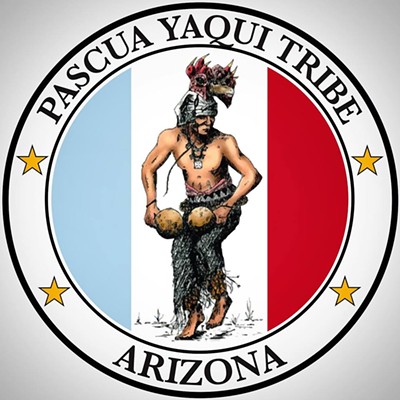You could hear a rumbling in the West University Neighborhood last week. It was the sound of a streetcar named big money.
And ultimately, that well-heeled juggernaut could rip through the very soul of Tucson's downtown communities.
The latest pit stop was the night of Tuesday, Feb. 28, at City Hall, where members of the Tucson City Council prepared to rubber-stamp a massive rezoning, thereby rendering the eastern fringe of West University amenable to at least two high-rise student apartment buildings. Near the planned streetcar route, and reaching up to 14 stories, those edifices could overshadow and most likely doom historic properties strung along North Euclid Avenue that vary from pristine to decrepit.
The move has sparked fierce opposition from many neighborhood residents, who saw it as a done deal long before they were brought to the table—one orchestrated by city officials listening to developers' promises, and panicky that the streetcar project could become a $300 million flop.
West University residents consider this only the latest in a series of rapid-fire rezonings that treat neighborhood concerns as an unwanted stepchild. The city is considering at least four special districts in the downtown area, each offering development sweeteners that range from tax waivers and eased zoning to slashed planning fees.
City Hall is also revamping its land-use code, a Byzantine document decried by business as overly cumbersome. But neighborhood leaders fear the revised document could contain few protections for historic properties, paving the way for demolition whenever preservation clashes with development. In West University alone, the city's own historic-preservation officer has predicted that dozens of historic structures could fall, threatening the neighborhood's status as a nationally registered historic district.
All of which accounts for the bristling crowd in the council chambers as Ernie Duarte, director of the city's Planning and Development Services Department, breezed through a rundown of zoning changes slated for the area, largely commercial, buffering the UA from West University homes. The rezoning would amend the existing West University Neighborhood Plan in this "transition area" by drastically boosting allowed heights and densities, even as it loosens restrictions on the use of historic properties.
"The Main Gate Urban Overlay District has been designed to create an urban neighborhood ... with multi-modal options," Duarte told the council. It will "use best practices for design and pedestrian comfort, encourage mixed uses by diverse populations, encourage restoration of historic buildings when possible, and create a streamlined development-review process for transit-oriented development."
Much of the audience offered a loud moan when city planner Jim Mazzocco unveiled drawings of the massive towers planned by Chicago-based developer Campus Acquisitions.
Demion Clinco is president of the Tucson Historic Preservation Foundation, and a member of the Tucson-Pima County Historical Commission. Contacted shortly before the Feb. 28 meeting, he described a topsy-turvy planning process in which historic concerns were raised only at an 11th-hour meeting with Mazzocco and a Campus Acquisitions consultant.
"This never had anything to do with historic preservation when it started off," Clinco said. "So suddenly, historic preservation had to be injected into it. It became this really difficult scramble to try to fit the historic-preservation language around the goals of this developer.
Mazzocco concedes that the Historical Commission was brought into the process late. But he says the City Council had directed his staff to work closely with the West University Neighborhood in finding a balance between preservation and development. He also claims that the rezoning overlay contained preservation incentives from the get-go. "And after we talked with the Historical Commission, we cleared up some things. They used certain terminology that we weren't using. We changed that terminology and clarified it."
As a result, says Mazzocco, the plan now contains several enticements for readapting historic properties rather than tearing them down. Those carrots include relaxed parking requirements and a 50 percent reduction in development-review fees. In addition, he says, demolition permits for historic structures now require several new layers of review.
Richard Mayers is vice president of the West University Neighborhood Association. Although area residents were able to wrest some preservation concessions, he says they never harbored illusions about the battle at hand. "The city wanted an outcome, and this process was tailored to achieve that outcome."
If so, that preordination was brought to bear on Feb. 28, when the council approved the rezoning overlay. But in so doing, it may have invigorated a pushback from newly energized inner-city neighborhoods. Three days after that vote, West University residents unleashed a referendum drive to overturn the new ordinance, and called for assistance from its counterparts throughout the downtown area.
Ward 1 Councilwoman Regina Romero was among those who backed the rezoning. She describes trying to find balance between fiercely competing interests. "I wanted to avoid the perception that we are only serving a couple of developers," she says, "and start everyone on a level playing field, and include the areas that I believe need redevelopment and reinvestment.
"So we said, 'OK, let's try and work this urban overlay so that we can encourage infill development, (and) we can encourage infill development and density.'"
While still torn over the issue, Romero applauds the goal of concentrated student housing. "I don't want to see more minidorms going into neighborhoods or along the streetcar line," she says. "And I do see the need for growing up (with high-rises). I felt this was a perfect area to go up."
Representing Ward 3, Councilwoman Karin Uhlich was alone in opposing the rezoning, after trying—and failing—to exempt a particularly sensitive historic area. If you need evidence of a lousy planning process, she suggests, you need to look no further than the acrimony of that night's meeting.
Uhlich notes confusion about which areas would be included in the rezoning overlay. She says some affected property owners in the Main Gate commercial area didn't even know changes were afoot. "That does not bode well for the process, to have a lack of understanding among the key players even about what area is to be examined.
"What I saw," she says of the Feb. 28 meeting, "just continued to reflect what I feel is a really fragmented plan. ... The process did not bring people together to come up with the best solution. I just think we could have done better."












